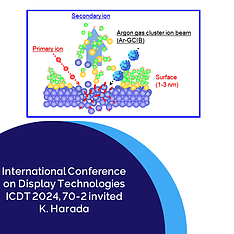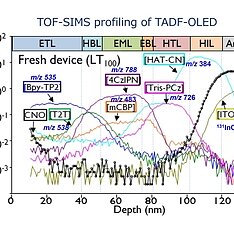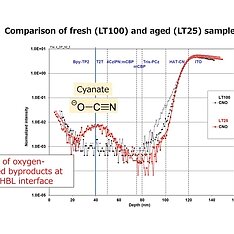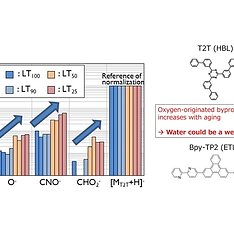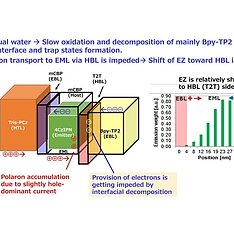Analysis of TADF-OLED Degradation by GCIB-TOF-SIMS and Study of Water Impact with In Situ Exposure Methodology
Gas cluster ion beam time-of-flight secondary ion mass spectrometry (GCIB-TOF-SIMS) is a powerful tool for depth profile analysis of a multilayer OLED stack. The results of study discussed here is the outcome from collaboration with Toray research Center Inc.
To study the depth distribution of organic compounds before and after OLED degradation, we prepared four TADF-OLED samples with all the same structure: One without aging (LT100) and others aged with a constant current density 20 mA/cm2 down to 90 % (LT90), 50 % (LT50) and 25 % (LT25) relative to the initial luminance. We then performed GCIB-TOF-SIMS depth profiling of relevant organic compounds of the four samples to understand the behavior of molecular decomposition through the device operation.
Relatively large number of secondary ion peaks of oxygen-originated fragments such as oxygen radical (O-), cyanate (CNO-) and hydrocarboxyl (CHO2-) were detected especially at around the interface between the hole blocking layer (HBL: T2T) and the electron transport layer (ETL: Bpy-TP2). The intensity of O-, CNO- and CHO2- peaks clearly increased after prolonged aging (LT50 and LT25).
Combining with results from in situ water exposue experiments, it is reasonable to consider the residual water in the vacuum chamber to be the weak oxidant of Bpy-TP2. In our TEDF-OLED architecture, the decomposition of the molecules at the ETL/HBL interface would not the direct root-cause of the exciton quenching. However, it impedes and deteriorates electron transport to the EML via HBL. Therefore, with increasing the time of aging, the change in the charge balance will induce a shif of the emission zone to the HBL side and eventually, the excitons are subject to quenching.


